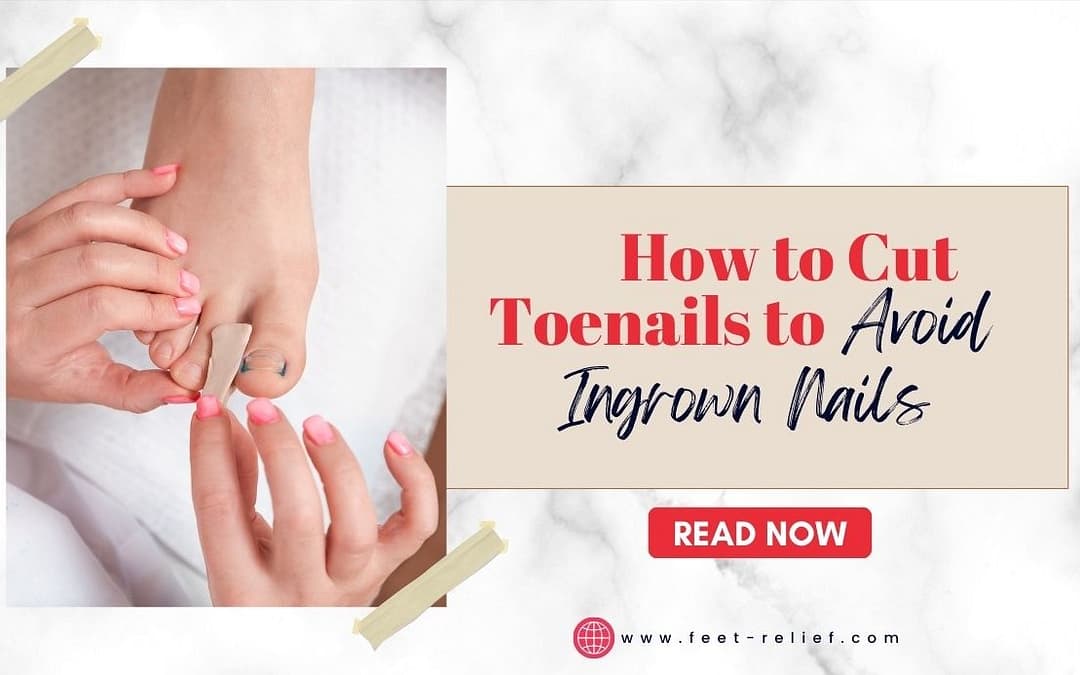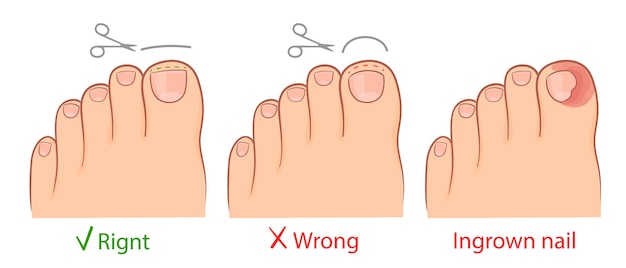Feet-Relief is supported by our audience. When you purchase through one of our links, we may earn a small affiliate commission. As an Amazon Associate I earn from qualifying purchases.Your cost is not affected.
Ingrown nails cause pain and often lead toward infections. Understanding how to cut toenails to avoid ingrown nails is essential for all ages. Often, people want to cut their nails to correspond with the curve of the toe. But this may create the perfect site for that ingrown toenail. Read on for details and tips to keep your toenails at their best.
Master the Art of Toenail Trimming: How to Cut Toenails to Avoid Ingrown Nails
Image Source: FreeImages
Introduction to toenail trimming
Toenail trimming is an essential part of personal hygiene and overall foot health. Regularly cutting your toenails can help prevent foot problems such as ingrown nails, infections, and even pain when wearing shoes. However, many people struggle with knowing how to cut toenails to avoid ingrown nails and other issues. This article aims to guide you through the process of mastering the art of toenail trimming, preventing ingrown toenails, and ensuring proper foot care.
Taking care of your feet is crucial, not only for maintaining a good appearance but also for preventing foot issues that can lead to discomfort and even infections. Learning how to cut toenails to avoid ingrown nails is a vital skill that will help you maintain your foot health and avoid complications.
In this article, you will learn about common toenail problems, the tools you need for proper toenail trimming, a step-by-step guide on how to cut toenails to prevent ingrown toenails, and more.
Related: Best Toe Nail Care Kit
Common toenail problems: Ingrown nails
Ingrown nails are one of the most common toenail problems people face. An ingrown toenail occurs when the nail begins to grow into the surrounding skin, causing pain, inflammation, and sometimes even infection. Some factors that contribute to ingrown nails include improper toenail trimming, tight-fitting shoes, and heredity.
Ingrown toenails can be extremely painful and can lead to serious complications if not treated properly. In some cases, ingrown nails can become infected, leading to a condition known as paronychia. This infection can spread to the surrounding tissue, potentially causing more severe problems such as cellulitis or even an abscess.
Knowing how to cut toenails is essential to avoid ingrown nails and minimize the risk of developing this painful condition. Following the correct toenail trimming techniques can help prevent ingrown toenails and maintain healthy feet.
Understanding the anatomy of a toenail
Before learning how to cut toenails to avoid ingrown nails, it’s important to understand the anatomy of a toenail. The toenail is made up of several layers, including the nail plate, nail bed, and nail matrix. The nail plate is the visible, hard part of the toenail that we trim. The nail bed is the soft tissue underneath the nail plate, and the nail matrix is the area at the base of the toenail where new nail cells are produced.
Knowing the anatomy of a toenail can help you understand how to cut toenails to prevent ingrown toenails. You can minimize the risk of developing ingrown nails and other complications by cutting the nail plate correctly and avoiding cutting into the nail bed or matrix.
Related: Causes of Toe Pain and Useful Tips
The right tools for toenail trimming
Selecting the right tools for toenail trimming is essential in learning how to cut toenails to avoid ingrown nails. Using the wrong tools or methods can cause damage to your toenails and increase the risk of ingrown toenails.
When selecting a tool for toenail trimming, look for a pair of sharp, high-quality nail clippers or nail scissors specifically designed for toenails. Additionally, these tools should have a curved shape. This helps you achieve the proper rounded cut that can prevent ingrown toenails. Avoid using regular scissors or clippers designed for fingernails, as these can cause damage to your toenails and may not provide the correct shape for preventing ingrown nails.
In addition to nail clippers or scissors, you should also have a nail file or emery board on hand. This tool is used to smooth out any rough or jagged edges left after trimming, helping to prevent any sharp corners from digging into your skin and causing an ingrown toenail.
Step-by-step guide: How to cut toenails to avoid ingrown nails
Follow this step-by-step guide on how to cut toenails to prevent ingrown toenails and maintain healthy feet:
- Clean your feet: Before trimming your toenails, make sure your feet are clean and dry. This helps prevent the spread of bacteria and makes it easier to see the nail properly.
- Soften your nails: Soak your feet in warm water for 10-15 minutes to soften your nails, making them easier to trim.
- Choose the right tool: Use a high-quality pair of nail clippers or nail scissors specifically designed for toenails.
- Trim your nails straight across: Hold the clippers or scissors parallel to your toenail and make small, straight cuts across the nail. Avoid cutting the toenails too short or cutting into the corners, as this can increase the risk of ingrown nails.
- Round the edges: Use a nail file or emery board to gently round the edges of your toenails, smoothing out any sharp corners or rough spots.
- Clean your tools: After trimming your toenails, clean your clippers or scissors with rubbing alcohol to prevent the spread of bacteria and ensure your tools are ready for the next use.
Tips for preventing ingrown toenails
How to cut toenails to avoid ingrown nail pain
In addition to learning how to cut toenails to avoid ingrown nails, there are other steps you can take to help prevent this painful condition:
- Wear properly-fitting shoes: Tight shoes put pressure on your toenails, increasing the risk of ingrown nails. Ensure your shoes provide enough room for your toes and avoid wearing high heels or pointed shoes for extended periods.
- Keep your feet clean and dry: Good foot hygiene can help prevent ingrown toenails. Wash your feet daily and dry them thoroughly, especially between the toes.
- Avoid trauma to your toenails: Activities that put repeated pressure on your toenails, such as running or dancing, can increase the risk of ingrown nails. Wear appropriate footwear and give your feet time to rest and recover.
How to deal with ingrown toenails
If you do develop an ingrown toenail, there are several steps you can take to manage the condition and prevent complications:
- Soak your feet: Soaking your feet in warm water mixed with Epsom salt can help relieve pain and reduce inflammation.
- Apply antibiotic ointment: Using an over-the-counter antibiotic ointment can help prevent infection.
- Keep the area clean and dry: Make sure to keep the affected area clean and dry to promote healing and prevent infection.
- Wear comfortable shoes: Avoid tight or restrictive footwear that could put pressure on the ingrown toenail.
If your ingrown toenail becomes infected or does not improve with home treatment, it’s important to see a doctor or podiatrist for professional care.
Professional treatments for ingrown toenails
In some cases, professional treatments may be necessary to address ingrown toenails. These treatments may include:
- Partial nail avulsion: This procedure involves removing part of the affected toenail to allow the ingrown nail to heal properly.
- Complete nail avulsion: In more severe cases, the entire toenail may need to be removed to treat the ingrown nail and prevent further complications.
- Nail matrixectomy: This procedure involves the removal of the nail matrix to prevent the ingrown toenail from recurring.
If you’re concerned about an ingrown toenail or struggling with how to cut toenails to avoid ingrown nails, consult with a healthcare professional for guidance and treatment.
Frequently asked questions about toenail trimming and how to cut toenails to avoid ingrown nails:
Q: How often should I trim my toenails?
A: You should trim your toenails every two to three weeks. Of course, that depends on how fast they grow.
Q: Can I use regular scissors to trim my toenails?
A: It’s best to use nail clippers or nail scissors specifically designed for toenails. Regular scissors can cause damage and increase the risk of ingrown nails.
Q: Can I use the same tools for trimming my fingernails and toenails?
A: It’s best to use separate tools for trimming your fingernails and toenails. The tools designed for toenails are typically larger and more robust. This allows for a clean, precise cut.
Q: How long should toenails be?
A: According to Healthline.com, “It’s recommended that you maintain your toenails at a length of about 1 to 2 millimeters (0.04 to 0.08 inches).”. Cut too short and you risk ingrown toenails. Left too long and you risk problems with your footwear or damaging the toe and nail if it hits a hard surface.
Related: Understanding Common Foot Problems
Use these tips for maintaining healthy toenails
Learning how to cut toenails to avoid ingrown nails is an essential skill for maintaining healthy feet. It also helps prevent painful foot problems. Select the right tools, follow proper trimming techniques, and practice good foot hygiene. This ensures you reduce the risk of ingrown toenails and keep your feet looking and feeling their best.
Remember to consult with a healthcare professional if you have concerns about your toenails or need guidance on how to cut toenails to prevent ingrown toenails. Don’t let ingrown nails stand in the way of your foot health and comfort – master the art of toenail trimming and enjoy healthy, pain-free feet.
Amazon and the Amazon logo are trademarks of Amazon.com, Inc, or its affiliates.



